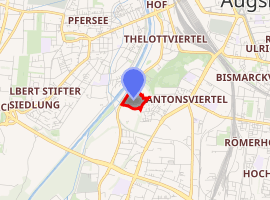Rosenaustadion
Rosenaustadion is a multi-purpose stadium in Augsburg, Bavaria, Germany. It is the second largest stadium in the city.

| |
| Location | Augsburg, Germany |
|---|---|
| Owner | City Augsburg |
| Capacity | official: 28.000 |
| Construction | |
| Opened | September 16, 1951 |
| Renovated | 2007 |
| Construction cost | 1.1–1.8 million DM |
| Architect | Erste Pläne: Thomas Wechs, Ausführung: Stadtbaurat Werner |
| Tenants | |
| FC Augsburg | |
Until 2009, the stadium was used mostly for football matches by the club FC Augsburg. It has an official capacity of 32,354 people. It was built in 1951. In 2009, it was replaced by the WWK ARENA.
History
The stadium was built from 1949, using debris from the aerial bombings of the Second World War. The original plans for the stadium however go back to 1926. A temporary narrow gauge railway line ran from 1946 from the city centre to the construction site, carrying 185,000 tonnes of debris to be used at the new stadium.
The Rosenaustadion was opened on 16 September 1951 with a Germany versus Austria football match, a B-international, drawing a crowd of 51,000.
From 1951 to 1972 the Rosenaustadiom possessed an outstanding meaning for German sport, particularly in the disciplines of football and athletics, due to its size and modernity. With the opening of Munich's Olympiastadion for the 1972 Summer Olympics, this position was lessened. Despite this, the stadium did host five football matches during these games.

The record attendance of FC Augsburg dates from 1973 with the game against the 1. FC Nürnberg with 42,000 spectators. The highest attendance at a football game was nearly 65,000 spectators on 9 November 1952 with the international match Germany – Switzerland.
The total record is from the year 1958, as 85.000 came to see the athletics team of Germany defeating the Russian team.
The record crowd for the home side FC Augsburg is 45,000, which attended the game in the Regionalliga Süd versus 1. FC Nürnberg on 3 August 1974.
References
| Wikimedia Commons has media related to Rosenaustadion. |
- 1972 Summer Olympics official report. Volume 1. Part 1. p. 121.
- 1972 Summer Olympics official report. Volume 3. p. 359.
- Official website (in German)
